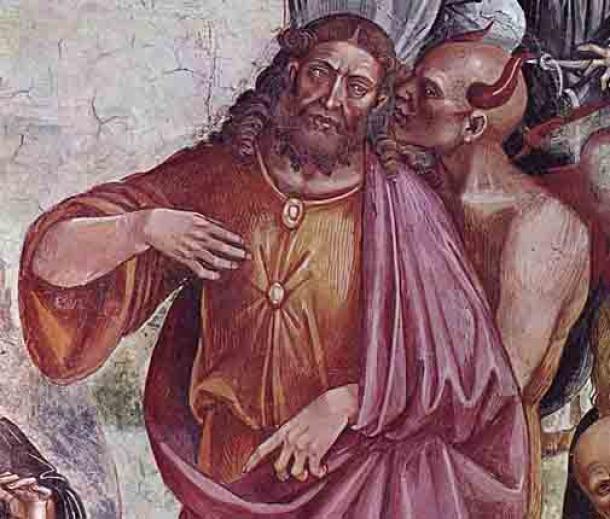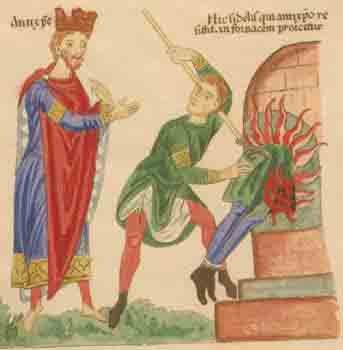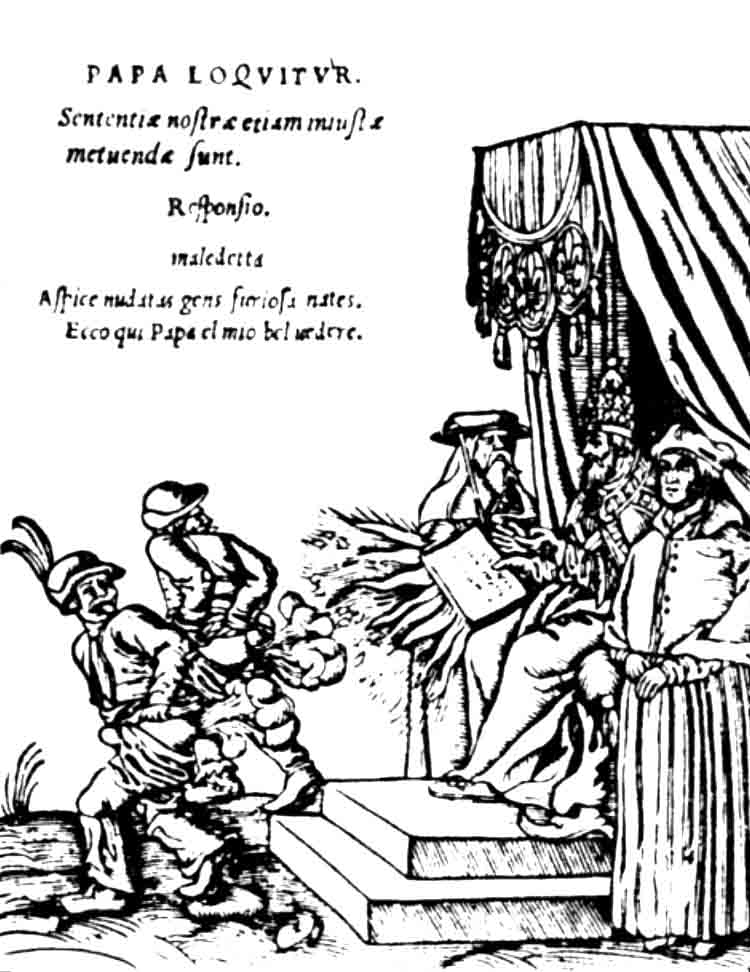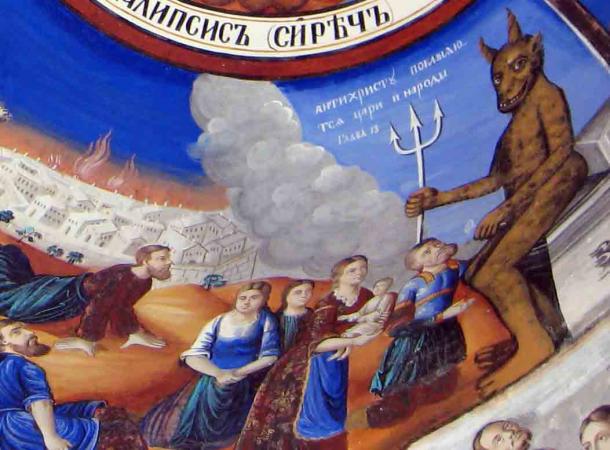The Antichrist. The name itself is enough to instill dread into the hearts of all devout Christians as well as others. It is a name that was ever connected to the negative, the malicious, and the fundamentally anti-Christian. And indeed, the Antichrist is a seldom mentioned but very malevolent entity from the Christian Bible. But the concept of a primordial, all-encompassing evil entity that threatens Christ and his devoted flock, and all of humanity was present for a very long time.
Bringer of Armageddon, herald of doom’s day, an evil without measure, a he, she, it, or something else entirely. The Antichrist is a complex concept. For the adherents of Christianity, this figure is prophesized to fool the devoted folk, coming in Christ’s place to do evil, until the real Christ reappears at the Second Coming. But is there more to this idea than first meets the eye?

Luca Signorelli’s 1501 depiction of the face of the Antichrist at the Orvieto Cathedral, Italy. (Luca Signorelli / Public domain )
Understanding The Antichrist Concept
“The One who denies the Father and the Son” is how the Bible describes the Antichrist. In the entire Bible, the term “Antichrist” is mentioned only five times, surprisingly, and all of them in the 1st and 2nd Epistles of John. However, a similar but not the same name appears in some of the Gospels, mainly of Matthew and Mark: pseudochristos ( false Christ). Here the term relates to the so-called “false prophets” who would come amongst the disciples of Christ performing many wonders and miracles to fool the good flock.
In the Epistles of John, one of the crucial verses describes the Antichrist not as a single person or an entity, but rather as a multitude of them, perhaps signifying that the Antichrist is a universal concept that would pertain to many persons with the same malicious intent. This verse tells us:
“Little children, it is the last hour: and as you have heard that Antichrist cometh, even now there are become many Antichrists: whereby we know that it is the last hour.” - 1 John 2:18
Once again, in 1st John Chapter I, we see mention of many deceivers who are, by being the enemies of Christ, Antichrists as well:
“Many deceivers have gone out into the world, those who do not confess that Jesus Christ has come in the flesh; any such person is the deceiver and the Antichrist!” – 2 John 1:7
In search of the Antichrist, we naturally need to look to the very early beginnings of the Christian Church and its first theologians and elders. One such was Polycarp, a follower of John the Apostle and an early Christian bishop who was martyred by being burned at the stake and stabbed in 155 AD by the Romans. He was one of the first to use the term Antichrist outside of the Bible while addressing his disciples amongst the Phillipians, telling them that all those who preached false doctrines and denied the Lord were Antichrists. Once more, we can see that it is not a single person he talks of but many.

The Antichrist, left, shown with attributes of a king, many of whom were viewed as greedy and evil through the ages. ( Public domain )
The Antichrist As The Herald Of The End Times
But as the history slowly unraveled, the concept of the Antichrist shifted from either a single fundamentally evil being to a group of wrongdoers and false prophets. Likewise, various Christian theologians, monks, asketes, and bishops, often believed that the crucial historic events during their lives were to herald the coming of the Antichrist. Here we must remember that throughout history, the world has seen some immense events unravel that shook and changed the world and claimed many lives too. It would be quite reasonable for a devoted Christian to believe such events to be the end days.
A great example of this is the fall of the Western Roman Empire, a major historical turning point. A notable early Christian theologian, Tertullian, considered this event as the opening of the way forward for the Antichrist. But Tertullian’s contemporary, one of the most important early Christian theologians, Hippolytus of Rome, thought that the Antichrist was a figure from one of the Tribes of Israel, the Tribe of Dan. He argued that this person or entity would rebuild the third Jewish temple on the Temple Mount in Jerusalem and rule from there.
However, some other important asketes and theologians emphasized the concept of the Antichrist as a necessity within the Biblical prophecy. Saint Jerome said: “Unless the Roman Empire should first be desolated, and Antichrist proceed, Christ will not come.”
Interestingly, one of the major works about the Antichrist came several centuries later, in the early Middle Ages. It was an abbot of a Benedictine French monastery, the Abbey of Montier-er-Der, that first shed major light on the concept of the Antichrist. His name was Adso ( of Montier-er-Der) and one of his major literary works was the so-called “ De ortu et Tempore Antichristi,” more commonly known as simply “De Antichristi.” His work was a unique “biography” of the Antichrist, which was both an exegesis (critical interpretation) of the original apocalyptic texts and utilized Sybilline lore (divine interpretations by Greek oracles). His work became the most influential writing related to the Antichrist in the entire medieval world and was copied many times, becoming an enormous influence in the Church.

The Papal Belvedere by Lucas Cranach the Elder in the 1545 publication of Luther’s depiction of the papacy, which was viewed as the Antichrist by many Protestant movements. It features a papal bull complete with fire and brimstone, fresh from the hand of Pope Paul III meeting German peasants with farts. (Lucas Cranach the Elder / Public domain )
But with the onset of the Middle Ages , as the Christian Church gained more power, prestige, and influence in world politics, the Antichrist became a concept loosely thrown around, often utilized for purposes of intrigue, slander, and propaganda. So it was that Arnulf, the Bishop of Reims, was greatly displeased by the conduct of the Pope John XV.
The Catholic Church, then and now, was often a point of content in the Christian World, known for the lavish lifestyle of its elders, the enormous wealth, the sin, and so forth. Thus, Arnulf accused Pope John XV of being the Antichrist! He connected him with the Antichrist of the Bible, saying that “ he is Antichrist sitting in God’s temple and showing himself as God.”
This tradition of filthy rich Church officials accusing one another of being the Antichrist just because one was wealthier than the other continued throughout the Middle Ages. Wilbert, archbishop of Ravenna and later Pope Clement III, was accused by his rival, Pope Gregory VII, of being the Antichrist, mainly because of their feuding.

The Antichrist clearly pictured in a fresco from the Osogovo Monastery, Republic of Macedonia. (Edal Anton Lefterov / CC BY-SA 3.0 )
Riches Or Penitence? The Reformation And The Antichrist Pope
Arguably the biggest focus on the concept of the Antichrist came during the famous Protestant Reformation period, when key reformers such as Martin Luther, John Wycliffe, Thomas Calvin, and John Knox all emphasized their view of the Pope being the actual Antichrist. During their reformation, they believed that the early Christian Church had been led to the so-called Great Apostasy with the rise of the Papacy, which constituted the false prophets of the Bible. This was a somewhat metaphorical view: Martin Luther stated that the Papacy itself was the Antichrist because it was “ an institution opposed to Christ.”
This idea was furthered by the so-called Magdeburg Centuriators, a group of scholars and followers of Martin Luther, who jointly wrote Magdeburg Centuries , a 12-volume ecclesiastical history that fully discredited the Pope and the Papacy. Once the book became widely read, the general Protestant public believed that the Pope was the Antichrist.
The reformations and the emergence of Protestant Christianity led to several different offshoot movements such as the Presbyterians, the Methodists, Calvinists, Baptists, and Anabaptists. All of them retained the concept of the Antichrist, often devotedly identifying it with the Pope. John Wesley, an English theologian who led to the rise of Methodism, wrote in his Explanatory Notes Upon the New Testament , that “the whole succession of Popes from Gregory VII are undoubtedly Antichrists. Yet this hinders not, but that the last Pope in this succession will be more eminently the Antichrist, the Man of Sin, adding to that of his predecessors a peculiar degree of wickedness from the bottomless pit.”
One must consider the endlessly progressive and liberal policies of the Catholic Church through the ages—the immense accumulation of wealth, the instigation of wars, lavishness and splendor, and all manners of sin that go against the teachings of true Christianity—to understand just why the Papacy was viewed as the true Antichrist.
It is curious to note that the Antichrist appears not only in Christianity but “crosses over” into other major religions as well. “The Deceiving Messiah,” in Arabic Al-Masih ad-Dajjal ( الدّجّال), is also a crucial concept in Islamic belief, much akin to the Antichrist of Christianity. However, it is not mentioned in the Islamic holy book, the Quran, but rather in the Hadith, a source of religious and moral law amongst Muslim believers. In these writings, the False Prophet is said to appear in the east, deceiving believers by performing miracles and healings just like Jesus but secretly aided by demons. Remember that Jesus also appears as a key figure in Islamic Quran. ʿĪsā ibn Maryam ( عِيسَى ٱبْنُ مَرْيَم َ), Jesus, son of Mary, is in the Quran the penultimate prophet and messiah of Allah (God). The Hadith goes on to say that the Antichrist would be followed by extreme Jewish power. However, Jesus is prophesized to rise again, defeating the Antichrist at the gates of Al-Ludd (modern day Lod, a city outside Tel Aviv in Israel).

The Antichrist continues to live in our imaginations thanks to modern movies and books. ( Benjamin Haas / Adobe Stock)
The Antichrist: From Religion To Music And Movies
Most depictions of the Antichrist throughout the ages were not of some devilish, malicious creature. On the contrary, they were of a benevolent man, who secretly deceives and undermines the true followers of Christ. Therefore, we often see richly garbed benevolent kings in medieval illustrations depicted as the Antichrist. The concept of “a false messiah” itself dictated that Christian believers variously describe their opponents as the Antichrist, giving the whole concept a sort of “tag” used throughout the centuries.
The concept of the Antichrist was also used throughout modern times, often as a theme or character in books, music, and movies. It is a recurring theme within the Black Metal music niche, where it is often conceptualized in various forms, of which some emphasize a different viewpoint on the entire Antichrist subject. The Antichrist has also appeared in movies. One you all know is “ The Omen,” the 1976 AD supernatural horror movie that follows the story of an odd boy, Damien Thorn, who is in fact the prophesized Antichrist. In a way, this form of entertainment served to further the idea of the Antichrist, keeping it firmly cemented in religious and cultural beliefs.
However, one needs to ask whether it is time for us to abandon the belief in mythical figures and age-old prophesies, and the simplicity of dualistic belief and Semitic religions. We need to consider taking a step forward, evolving beyond the ideas of prophets and deceivers, of idolatry and false penitence. The world of the 21st century AD is in many ways still very much heathenish, even when under the guise of the cross.
True Christianity has remained for centuries in the sands with the Desert Fathers. The world of today is filled to the brim with false prophets, cult leaders, deceitful preachers, tele-evangelists, and Antichrists in the truest form. Looking at it from that angle, we realize that Antichrists are here and now, walking amongst us and not even hiding their falsehood and evil. One need only glance at the multimillionaire tele-evangelists and gospel “preachers,” Kenneth Copeland and David “the Apostle” Taylor, to understand that the Antichrist—that inherent maliciousness threatening the purity of a righteous man—is here and amongst us, within modern human beings.
An Evil That Does Not Age
Nevertheless, the Antichrist remains one of the cornerstones in Christian religious belief, a crucial concept directly connected with the prophecy of the Second Coming of Jesus. Throughout the ages, the name acquired a sort of universal role, being ascribed to anything or anyone malignant, evil, or anti-Christian in any way.
Whether you believe in it or not, whether you are religious or irreligious, it still can tickle the mind to ask yourself: is there truth to it, or no?
Top image: The Antichrist: a concept that was applied to all kinds of bad people including kings and popes! Source: Jakub Krechowicz / Adobe Stock
References
Pink, W. A. 1979. The Antichrist. CCEL.
Rhodes, R. 2012. Unmasking the Antichrist: Dispelling the Myths, Discovering the Truth. Harvest House Publishers.
Richardson, J. 2009. The Islamic Antichrist: The Shocking Truth about the Real Nature of the Beast. WND Books.
Upton, C. 2005. The System of Antichrist: Truth and Falsehood in Postmodernism and the New Age. Sophia Perennis.
Related posts:
Views: 0
 RSS Feed
RSS Feed

















 January 3rd, 2021
January 3rd, 2021  Awake Goy
Awake Goy  Posted in
Posted in  Tags:
Tags: 
















